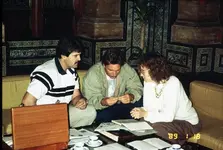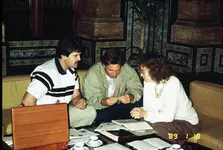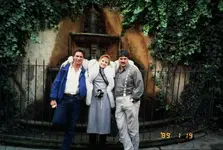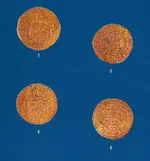Chagy
Bronze Member
- #1
Thread Owner
The Jupiter Wreck
On July 12, 1987, by Peter Leo, a lifeguard for the city of Jupiter. While taking a morning swim, Peter was astonished to find cannons protruding from the sand where he had been swimming hundreds of times before. They were located in the shadow of the Jupiter lighthouse, just to the south of the Jupiter Inlet jetty and off the public beach. Though not positively identified, it's believed to be those of the “San Miguel de Arcangel”, which was lost either late 1659 or early 1660. During the first two years, before the lease was approved, they hand-fanned the area around the cannons and anchors. No mechanical means of excavation were allowed until a formal state lease was approved. In Spite of this handicap they were able to recover over 1,200 silver coins, several gold coins, and an 80-pound silver bar minted in Lima, Peru, and complete with markings and a date...1652. So far the site has proved rewarding for the salvors. To date over 10,000 silver coins and almost 100 gold coins have been recovered. Two gold bars, as well as a few "bits" of gold, a silver bar weighing 80 pounds, a large copper cooking pot complete with dolphin handles, a pewter shaker box, two arquebuses (muskets), a silver fork, silver spoon, musket balls, cannon balls, and two cannon have been raised. Six more cannons remain on the site. The majority of the silver coins are from the Potosi mint and dated 1658. Twelve of the gold coins are two escudos from the Bogota mint. Also some rare transitional coins have been recovered, including a "Star of Lima" eight-reales and an eight-reales from the Cartagena mint.
Further archival research done by Victoria Stapells Johnson revealed that the Jupiter wreck fits the description of the:
“SAN MIGUEL ARCANGEL”
Dispatched by the Viceroy of Peru, the “San Miguel Archangel” sailed as primer aviso under Juan Ramirez de Miranda, pilot Diego García and Captain Juan de Ostalaca from Portobelo for Spain on September 18, 1659. Six and half months later, the ship had not arrived in Spain and was feared to have wrecked. It was decided to send duplicates of all the correspondence on the next aviso to Spain in April 1660. On the backside of the letter there is a scribbled note “ The aviso ship under Juan Ramirez de Miranda wrecked on the coast of Florida” Included with this document is another longer report (23 pages) entitled “Testimonio sobre el despacho del navío “San Miguel Arcangel” que se despachó de aviso a los reinos de España por el Virrey del Perú a cargo de Juan Ramirez de Miranda” This deals with the financing and preparation of the ship to sail to Spain and there is no reference to what happened to it after leaving Portobelo. A list of the boxes of correspondence loaded on the ship is included. Nevertheless, it should be read through carefully in case there is any information on the ship itself. Juan Ramirez appears to have been a notable in Portobelo. In 1661, he was named notary of the city of Portobelo. It is suggested that further research on this man might shed some light on the aviso because he undoubtedly had cargo on board.
Source: A.G.I. – Santa Fe 43, ramo 3, n.10. Also: Panamá 58, n.1 Confirmación de oficio: Juan Ramírez de Miranda. 14 enero, 1662
Now let’s make a pause and go to Ecuador……
The Spanish galleon “Jesus Maria de la Limpia Concepcion”, better known as the “Capitana”, was lost in 1654 after striking a reef system off Chanduy Ecuador. The huge galleon served as the command ship, the "Capitana" of the 1654 South Sea Armada, and due to her size and stature, carried the bulk of the fleet’s treasure. Estimates place the amount at nearly 10 million pesos of silver, well above the annual production of the combined mints of the Spanish Viceroyalty of Peru. Most of the “Capitana's” treasure was promptly salvaged by the Spanish and part of her cargo was placed in the “Maravillas” to be lost again in 1656. The 1654 “Capitana” was rediscovered in 1997 by one of Dave Horner’s divers Rob McClung aboard Don McKay’s 100ft salvage vessel the “R/V Explorer”. Archaeologist John de Bry, examined the coins found and said the coins were struck between 1648 and 1652 in the mint at Potosi, Bolivia, which was at that time part of the vice royalty of Peru.
The Jupiter Wreck site was visited by Dave Horner and Don McKay in the late 90’s when it was discovered that the 80 pound silver bar minted in Lima, Peru with complete markings and a dated 1652 was part of the register manifest of the 1654 “Capitana”.
Further research revealed that the Count of Salvatierra is known to have loaded the 1654 “Capitana” with contraband treasure. The Count salvaged some of the treasure in the name of the King from the ship lost on the coast of Ecuador, but underreported the amount recovered and diverting a goodly portion to his own pockets. The Count Alba de Liste, who became Viceroy after Salvatierra’s death in 1658, mounted a second recovery expedition of the Chanduy wreck in 1659. Two hundred fifty thousand pesos were reported to have been recovered in this operation. The silver bar found at the Jupiter site taken from the Chanduy reef wreck was either part of Salvatierra’s plunder from the Chanduy reef wreck, shipped by his widow, the Countess, in anticipation of her return to Spain or salvaged by Count Alba de Liste in 1659.
Another interesting fact is that one of the 2 finger gold bars found at the Jupiter wreck had several coins encrusted to it and the coins were dated 1652.
So here we have found a connection between the 1659 “San Miguel Archangel” and the 1654 “Capitana.”
Now let’s make another pause and go to Bahamas…….
The “Nuestra Señora de las Maravillas” sailed the Almiranta of the homebound Spanish fleet in January of 1656, the “Maravillasas” was officially filled with over five million pesos of treasure (and probably much more in contraband, as was usually the case). That treasure included much of the silver salvaged from the South Seas Fleet’s “Capitana” of 1654 that wrecked on Chanduy Reef off Ecuador. The ill-fated treasure sank once again when the “Maravillas” unexpectedly exacerbated by strong winds ran into shallow water and was subsequently rammed by one of the other ships of its fleet, forcing the captain to try to ground the “Maravillas” on a nearby reef on Little Bahama Bank off Grand Bahama Island. Most of the 650 people on board the ship died in the night, and the wreckage scattered. Spanish salvagers soon recovered almost half a million pesos of treasure quickly, followed by more recoveries over the next several decades, yet with over half of the official cargo still unfound.
Now that we know of the connection between the 1654 “Capitana” and the Jupiter wreck one would understand why so many 1652 and earlier coins have been found in the Jupiter site. But is also very interesting the fact that many 1656 coins have been found in the Jupiter site.
I read an article online that talk’s about a Captain Bouchlas who found artifacts in the Jupiter area that match the manifest of the Maravillas. He them proceeded to apply for permits but it was too late because Peter Leo had already found the wreck and had permits in the area. Captain Bouchlas believes that the gold and intrinsic archaeological artifacts found at the Jupiter site match the manifest of the 1656 Maravillas he strongly believes that the Jupiter wreck is one of the two vessels that recovered treasure from the “Maravillas” at Memory Rock. These two vessels in order to gain water supplies traveled straight to Florida sailing on the same Lat 27 plus or minus degrees which put you right at the Jupiter lighthouse where they wrecked. Mr. Bouchlas claims that he can pinpoint the exact location of the so called “Golden Madonna” in Jupiter.
Steven Singer is his book ‘Shipwrecks of Florida” on page 134 has a listing of 1659 San Francisco y San Antonio a Spanish aviso vessel that wrecked at Gega present day Jupiter. Indians rescued 33 survivors. Source research by Dr. Eugene Lyon.
Victoria Stapells report provides a list of possible ID’s for the Jupiter wreck and interesting enough this is one of them:
“SAN FRANCISCO Y SAN ANTONIO”
In 1657 Bernardo Somoza requested that his ship, the “San Francisco y San Antonio” of 60 toneladas cargo capacity and built in Seville (Spain) be granted a license to sail to Tierra Firme as an aviso (courier ship). The outgoing manifest for this ship is in the section Contratación of the Archivo General de Indias. In it, there is information on the ship, artillery, ship fittings and a complete crew list as you will read in the transcription and translation included further on in this report. This aviso left Seville in February 1658 for the ports of Cartagena and Portobelo. There is no evidence that it returned.
Knowing that this report provides information on the artillery it makes me wonder if anyone has compared the amount, length, weight, etc. of cannons found in the Jupiter site to the amount, length, weight, etc. of cannons carried by the “San Francisco y San Antonio”
I would love to see the rest of this report, I am sure that it provides many important clues for further research on the “San Francisco y San Antonio”
Also in Victoria Stapells report:
In the different Audiencias of the archives, there is mention of two or three avisos which sank in this time period but for which we have no name:
- 33 men survived the wreck of this courier ship off the coast of Gega, Florida in 1659
Source: A.G.I. - Santo Domingo 233
- Mention of an aviso “which was lost” in a letter dated Panama, May 27 1659.
Source: A.G.I. – Panama 36
Intersting facts:
-Both ships were aviso vessels (couriers) sailing alone.
-Both ships left the port of Portobelo.
-If you look on a map at the spots in Bahamas where 1656 treasure has been found you will notice that they are almost in a straight line with the Jupiter inlet.
-Many 1656 coins have been found at the Jupiter wreck site.
-Many finger gold bars have been found in the “Maravillas” similar to the 2 bars found at the Jupiter wreck site.
Gold "finger" bar from the Maravillas (1656), 336.3 grams, 19-1/4K. About 7" x 1" x 1/4". A very wide and flat ingot with one end chisel-cut twice (a bit crudely) and the other end rounded but with two small, cylindrical assayer's bites, the marked surface with 3 fineness markings of XIX in a box...
Many questions come to my mind:
Was the “San Miguel” traveling with the “San Francisco y San Antonio”?
Did they stop to salvage the “Maravillas”?
Did they both wreck in Jupiter?
How much treasure is still to be found at the Jupiter wreck site?
(It is well documented the fact that the register cargo of the 1654 “Capitana” was 3,000,000 pesos to later find out that it was carrying over 10,000,000.)( For almost 8 years annual salvage expeditions were sponsored by two viceroys Don Garcia Sarmiento de Sotomayor, Count of Salvatierra from 1648 to 1655 and his successor Don Luis Henriques de Guzman Count de Alva of Aliste, Viceroy of Peru from 1655 to 1661. it is well documented that during those 8 years 3,339, 751 pesos were reported as salvage. Knowing there was so much contraband onboard I wonder how much was really salvage and never reported.
How much of this contraband goods were loaded into the “San Miguel Arcangel?
If the “San Miguel Arcangel” did in fact stopped to salvage the “Maravillas” How much more did it salvage?
If the so called “Golden Madonna” does exist could it really be at the Jupiter site?
(I heard that the “Golden Madonna” doesn’t exist. The story I heard is that Gene Lyon pulling Marx leg told him that the “Maravillas” was carrying a “Golden Madonna” and the next thing Gene knew Marx had written about it in one of his books)
On July 12, 1987, by Peter Leo, a lifeguard for the city of Jupiter. While taking a morning swim, Peter was astonished to find cannons protruding from the sand where he had been swimming hundreds of times before. They were located in the shadow of the Jupiter lighthouse, just to the south of the Jupiter Inlet jetty and off the public beach. Though not positively identified, it's believed to be those of the “San Miguel de Arcangel”, which was lost either late 1659 or early 1660. During the first two years, before the lease was approved, they hand-fanned the area around the cannons and anchors. No mechanical means of excavation were allowed until a formal state lease was approved. In Spite of this handicap they were able to recover over 1,200 silver coins, several gold coins, and an 80-pound silver bar minted in Lima, Peru, and complete with markings and a date...1652. So far the site has proved rewarding for the salvors. To date over 10,000 silver coins and almost 100 gold coins have been recovered. Two gold bars, as well as a few "bits" of gold, a silver bar weighing 80 pounds, a large copper cooking pot complete with dolphin handles, a pewter shaker box, two arquebuses (muskets), a silver fork, silver spoon, musket balls, cannon balls, and two cannon have been raised. Six more cannons remain on the site. The majority of the silver coins are from the Potosi mint and dated 1658. Twelve of the gold coins are two escudos from the Bogota mint. Also some rare transitional coins have been recovered, including a "Star of Lima" eight-reales and an eight-reales from the Cartagena mint.
Further archival research done by Victoria Stapells Johnson revealed that the Jupiter wreck fits the description of the:
“SAN MIGUEL ARCANGEL”
Dispatched by the Viceroy of Peru, the “San Miguel Archangel” sailed as primer aviso under Juan Ramirez de Miranda, pilot Diego García and Captain Juan de Ostalaca from Portobelo for Spain on September 18, 1659. Six and half months later, the ship had not arrived in Spain and was feared to have wrecked. It was decided to send duplicates of all the correspondence on the next aviso to Spain in April 1660. On the backside of the letter there is a scribbled note “ The aviso ship under Juan Ramirez de Miranda wrecked on the coast of Florida” Included with this document is another longer report (23 pages) entitled “Testimonio sobre el despacho del navío “San Miguel Arcangel” que se despachó de aviso a los reinos de España por el Virrey del Perú a cargo de Juan Ramirez de Miranda” This deals with the financing and preparation of the ship to sail to Spain and there is no reference to what happened to it after leaving Portobelo. A list of the boxes of correspondence loaded on the ship is included. Nevertheless, it should be read through carefully in case there is any information on the ship itself. Juan Ramirez appears to have been a notable in Portobelo. In 1661, he was named notary of the city of Portobelo. It is suggested that further research on this man might shed some light on the aviso because he undoubtedly had cargo on board.
Source: A.G.I. – Santa Fe 43, ramo 3, n.10. Also: Panamá 58, n.1 Confirmación de oficio: Juan Ramírez de Miranda. 14 enero, 1662
Now let’s make a pause and go to Ecuador……
The Spanish galleon “Jesus Maria de la Limpia Concepcion”, better known as the “Capitana”, was lost in 1654 after striking a reef system off Chanduy Ecuador. The huge galleon served as the command ship, the "Capitana" of the 1654 South Sea Armada, and due to her size and stature, carried the bulk of the fleet’s treasure. Estimates place the amount at nearly 10 million pesos of silver, well above the annual production of the combined mints of the Spanish Viceroyalty of Peru. Most of the “Capitana's” treasure was promptly salvaged by the Spanish and part of her cargo was placed in the “Maravillas” to be lost again in 1656. The 1654 “Capitana” was rediscovered in 1997 by one of Dave Horner’s divers Rob McClung aboard Don McKay’s 100ft salvage vessel the “R/V Explorer”. Archaeologist John de Bry, examined the coins found and said the coins were struck between 1648 and 1652 in the mint at Potosi, Bolivia, which was at that time part of the vice royalty of Peru.
The Jupiter Wreck site was visited by Dave Horner and Don McKay in the late 90’s when it was discovered that the 80 pound silver bar minted in Lima, Peru with complete markings and a dated 1652 was part of the register manifest of the 1654 “Capitana”.
Further research revealed that the Count of Salvatierra is known to have loaded the 1654 “Capitana” with contraband treasure. The Count salvaged some of the treasure in the name of the King from the ship lost on the coast of Ecuador, but underreported the amount recovered and diverting a goodly portion to his own pockets. The Count Alba de Liste, who became Viceroy after Salvatierra’s death in 1658, mounted a second recovery expedition of the Chanduy wreck in 1659. Two hundred fifty thousand pesos were reported to have been recovered in this operation. The silver bar found at the Jupiter site taken from the Chanduy reef wreck was either part of Salvatierra’s plunder from the Chanduy reef wreck, shipped by his widow, the Countess, in anticipation of her return to Spain or salvaged by Count Alba de Liste in 1659.
Another interesting fact is that one of the 2 finger gold bars found at the Jupiter wreck had several coins encrusted to it and the coins were dated 1652.
So here we have found a connection between the 1659 “San Miguel Archangel” and the 1654 “Capitana.”
Now let’s make another pause and go to Bahamas…….
The “Nuestra Señora de las Maravillas” sailed the Almiranta of the homebound Spanish fleet in January of 1656, the “Maravillasas” was officially filled with over five million pesos of treasure (and probably much more in contraband, as was usually the case). That treasure included much of the silver salvaged from the South Seas Fleet’s “Capitana” of 1654 that wrecked on Chanduy Reef off Ecuador. The ill-fated treasure sank once again when the “Maravillas” unexpectedly exacerbated by strong winds ran into shallow water and was subsequently rammed by one of the other ships of its fleet, forcing the captain to try to ground the “Maravillas” on a nearby reef on Little Bahama Bank off Grand Bahama Island. Most of the 650 people on board the ship died in the night, and the wreckage scattered. Spanish salvagers soon recovered almost half a million pesos of treasure quickly, followed by more recoveries over the next several decades, yet with over half of the official cargo still unfound.
Now that we know of the connection between the 1654 “Capitana” and the Jupiter wreck one would understand why so many 1652 and earlier coins have been found in the Jupiter site. But is also very interesting the fact that many 1656 coins have been found in the Jupiter site.
I read an article online that talk’s about a Captain Bouchlas who found artifacts in the Jupiter area that match the manifest of the Maravillas. He them proceeded to apply for permits but it was too late because Peter Leo had already found the wreck and had permits in the area. Captain Bouchlas believes that the gold and intrinsic archaeological artifacts found at the Jupiter site match the manifest of the 1656 Maravillas he strongly believes that the Jupiter wreck is one of the two vessels that recovered treasure from the “Maravillas” at Memory Rock. These two vessels in order to gain water supplies traveled straight to Florida sailing on the same Lat 27 plus or minus degrees which put you right at the Jupiter lighthouse where they wrecked. Mr. Bouchlas claims that he can pinpoint the exact location of the so called “Golden Madonna” in Jupiter.
Steven Singer is his book ‘Shipwrecks of Florida” on page 134 has a listing of 1659 San Francisco y San Antonio a Spanish aviso vessel that wrecked at Gega present day Jupiter. Indians rescued 33 survivors. Source research by Dr. Eugene Lyon.
Victoria Stapells report provides a list of possible ID’s for the Jupiter wreck and interesting enough this is one of them:
“SAN FRANCISCO Y SAN ANTONIO”
In 1657 Bernardo Somoza requested that his ship, the “San Francisco y San Antonio” of 60 toneladas cargo capacity and built in Seville (Spain) be granted a license to sail to Tierra Firme as an aviso (courier ship). The outgoing manifest for this ship is in the section Contratación of the Archivo General de Indias. In it, there is information on the ship, artillery, ship fittings and a complete crew list as you will read in the transcription and translation included further on in this report. This aviso left Seville in February 1658 for the ports of Cartagena and Portobelo. There is no evidence that it returned.
Knowing that this report provides information on the artillery it makes me wonder if anyone has compared the amount, length, weight, etc. of cannons found in the Jupiter site to the amount, length, weight, etc. of cannons carried by the “San Francisco y San Antonio”
I would love to see the rest of this report, I am sure that it provides many important clues for further research on the “San Francisco y San Antonio”
Also in Victoria Stapells report:
In the different Audiencias of the archives, there is mention of two or three avisos which sank in this time period but for which we have no name:
- 33 men survived the wreck of this courier ship off the coast of Gega, Florida in 1659
Source: A.G.I. - Santo Domingo 233
- Mention of an aviso “which was lost” in a letter dated Panama, May 27 1659.
Source: A.G.I. – Panama 36
Intersting facts:
-Both ships were aviso vessels (couriers) sailing alone.
-Both ships left the port of Portobelo.
-If you look on a map at the spots in Bahamas where 1656 treasure has been found you will notice that they are almost in a straight line with the Jupiter inlet.
-Many 1656 coins have been found at the Jupiter wreck site.
-Many finger gold bars have been found in the “Maravillas” similar to the 2 bars found at the Jupiter wreck site.
Gold "finger" bar from the Maravillas (1656), 336.3 grams, 19-1/4K. About 7" x 1" x 1/4". A very wide and flat ingot with one end chisel-cut twice (a bit crudely) and the other end rounded but with two small, cylindrical assayer's bites, the marked surface with 3 fineness markings of XIX in a box...
Many questions come to my mind:
Was the “San Miguel” traveling with the “San Francisco y San Antonio”?
Did they stop to salvage the “Maravillas”?
Did they both wreck in Jupiter?
How much treasure is still to be found at the Jupiter wreck site?
(It is well documented the fact that the register cargo of the 1654 “Capitana” was 3,000,000 pesos to later find out that it was carrying over 10,000,000.)( For almost 8 years annual salvage expeditions were sponsored by two viceroys Don Garcia Sarmiento de Sotomayor, Count of Salvatierra from 1648 to 1655 and his successor Don Luis Henriques de Guzman Count de Alva of Aliste, Viceroy of Peru from 1655 to 1661. it is well documented that during those 8 years 3,339, 751 pesos were reported as salvage. Knowing there was so much contraband onboard I wonder how much was really salvage and never reported.
How much of this contraband goods were loaded into the “San Miguel Arcangel?
If the “San Miguel Arcangel” did in fact stopped to salvage the “Maravillas” How much more did it salvage?
If the so called “Golden Madonna” does exist could it really be at the Jupiter site?
(I heard that the “Golden Madonna” doesn’t exist. The story I heard is that Gene Lyon pulling Marx leg told him that the “Maravillas” was carrying a “Golden Madonna” and the next thing Gene knew Marx had written about it in one of his books)




















